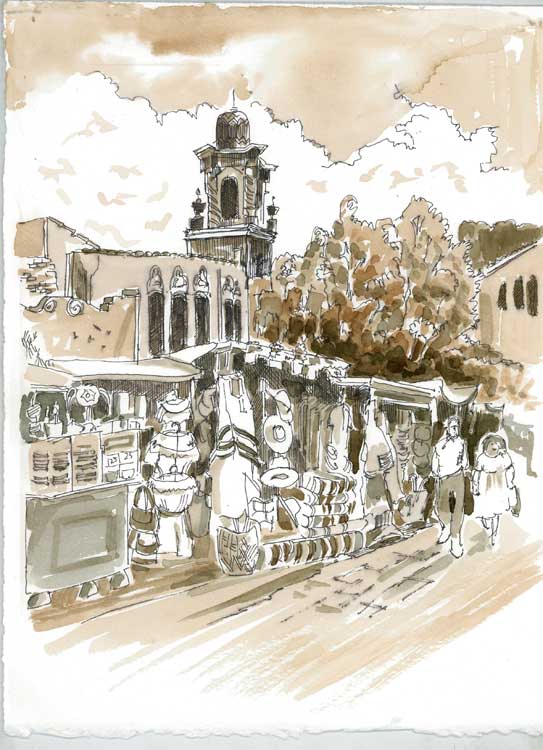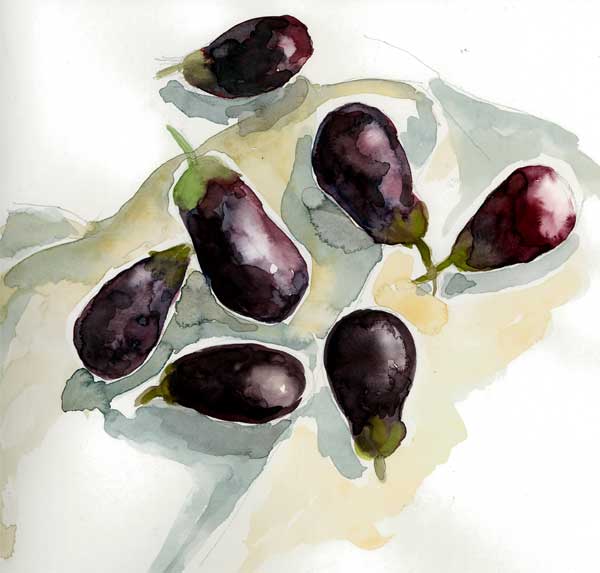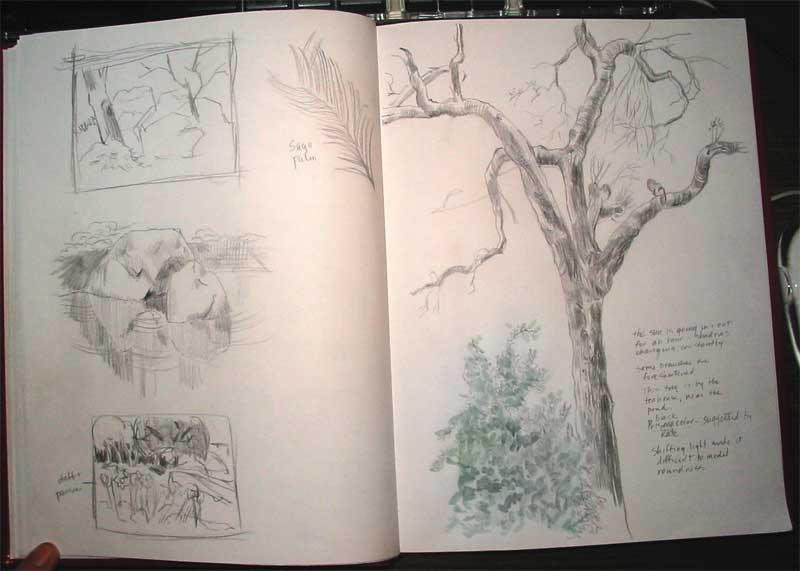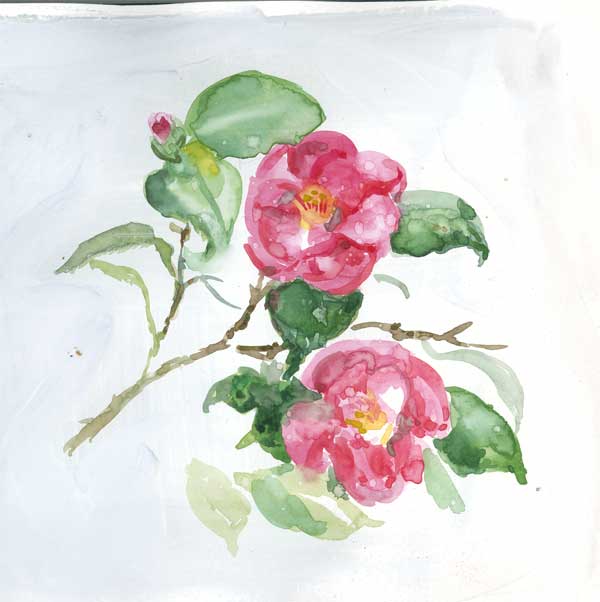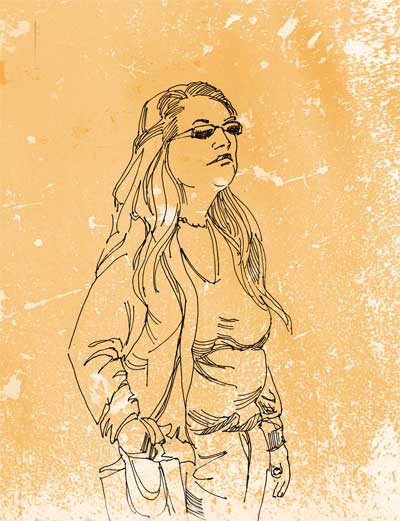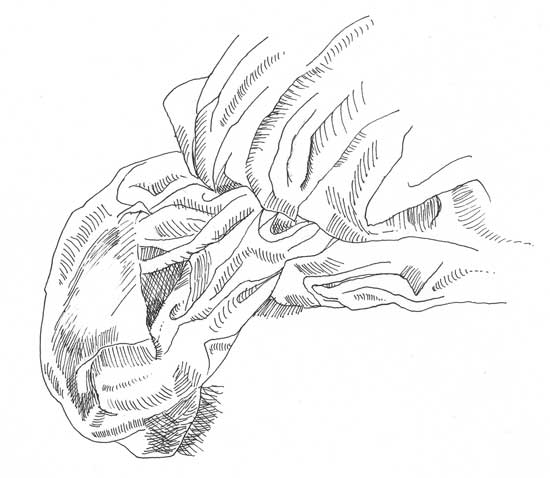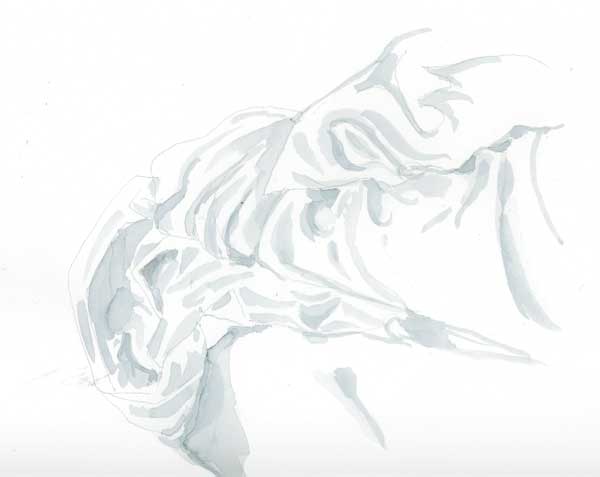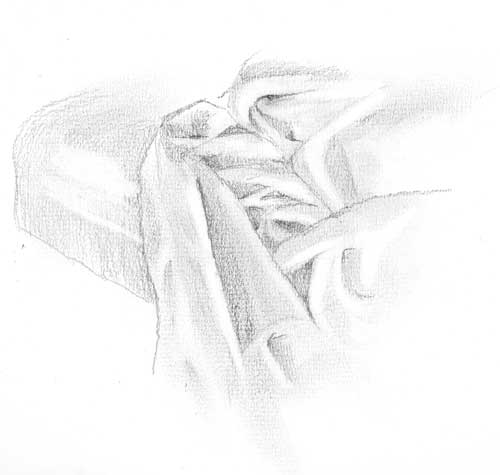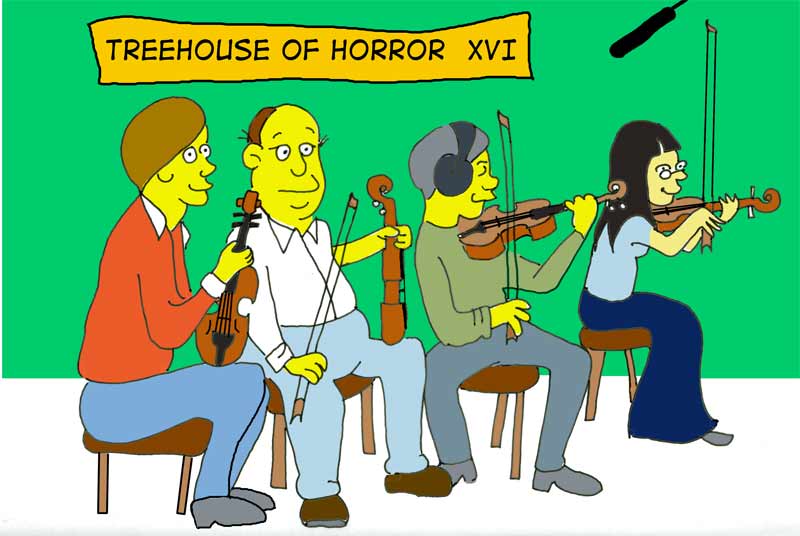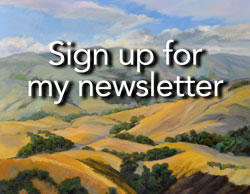Sketchcrawl Downtown #3 – Olvera Street
Click picture to enlarge
Here’s the third and last of my drawings I did last week on the sketchcrawl in downtown LA, and another response to the “draw a local landmark” challenge. With limited time for drawing I opted to spend the time drawing rather than doing washes or painting on location. Today I took some time to figure out how I wanted to handle those washes. As an experiment, I printed out the line drawing on watercolor paper rather than use the flimsier paper in my sketchbook. That also gave me a backup in case my ideas didn’t work – I could just toss the printed version out and print another one. In fact, I might paint one using bright colors instead of this monochrome/sepia scheme which is primarily based on tonal values.
Unlike the Union Station fountain painting, in this experiment I decided I would draw it as it actually was, because I liked the angle and the bustling activity following the morning’s rain. Also, unlike the courtyard painting, I opted for Rapidoliner and wash because I wanted to draw the small details of the shops instead of suggesting dabs of color with the brush. I did take a picture before I left, so I might still try an impressionistic watercolor sketch for comparison. Below is the drawing before painting, if you’re curious. Click to enlarge.
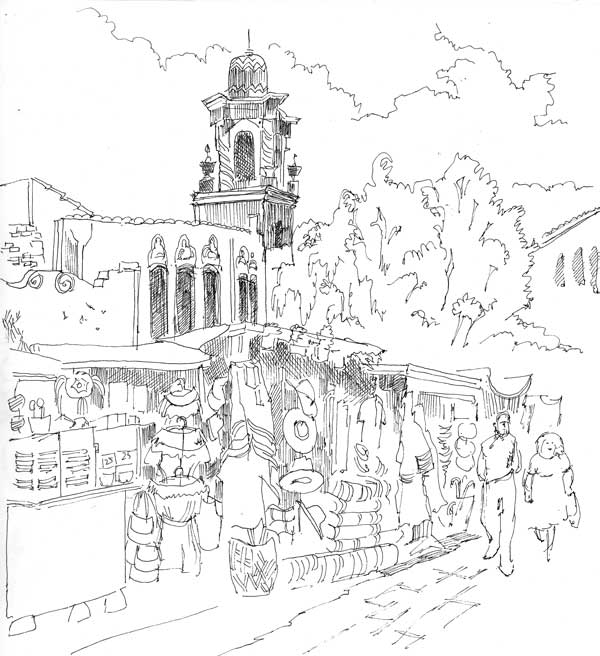
More vegetables – tiny eggplants
Another one for the “Draw a Vegetable” Challenge!
I had a terrific dish at a recent potluck and meeting of the Botanical Artists Guild of So. California. The hostess gave out the recipe to everyone present and I filed it away as something I wanted to try. Today, I saw these baby eggplants at the market and decided that I would give it a try. It includes small tender eggplants, italian parsley, diced tomatoes, calamata olives, garlic and some spices – all mixed with the hands and baked in a shallow pan. But like a raccoon who must wash everything before eating it, I often feel compelled to draw or paint it.
This was sketched in my Superdeluxe Aquabee workbook, 9 x 9, 90# weight. I learned some things from it that I’ll take into consideration in doing a real painting. The best thing I learned was which colors to use to get that eggplant color, and I figured out some ways to get the colors to mingle on the wet paper.
Another sketchcrawl page
My workbook is evolving, and so am I. Sometimes the mood strikes me to do compositional and value sketches; other times I might be captivated by the texture of a rock, carefully observing the nature of reflections. On Saturday, while hiding out from the sprinkling of rain under the teahouse roof, I settled in to do a long, slow drawing of a California Live Oak. The biggest challenge was trying to describe the volume of the limbs when the light kept changing (like the camellia painting I posted two days ago.) Still, it was a satisfying sketching session and I felt like I got to know this tree a little better.
Too big to fit under my scanner, this 9 x 12 Watson Guptill sketchbook is a good size for trees and big objects.
Camellias Sketchcrawl style
Saturday, four hardy artists braved the cold temperatures and sallied forth to Descanso Gardens for a sketchcrawl. Because it was sprinkling, our first stop was the Japanese teahouse with its sheltering roof, which protected us from the morning drizzle. We sketched there for an hour or more and then, seeing that the sun was peeking occasionally through the clouds, we ventured out into another part of the garden.
I stopped at a camellia bush where I painted this cluster for a little while. I used a page in my Canson watercolor journal that I had previously started at the Chinatown parade, then rapidly gave up on. (Digression warning) The only scribble on said page was a stiltwalker in drag wearing a slinky Chinese dress. Think “Al” from ToolTime (the flannel-shirted, bearded one) wearing a dress from The World of Suzie Wong, only imagine him 10 feet tall. Got the picture? There simply wasn’t time to capture him/her in all his/her glory, so I gave up somewhere between the mandarin collar and the flash of beefy thigh. However, being of a frugal nature, I painted over the page with a few coats of Liquitex acryllic gesso (white) figuring I’d do something else in that space.
The else moment arrived on Saturday. I painted these using my portable w/c palette (which I have since misplaced, unfortunately.) The first challenge was trying to figure out the values of the colors when the light conditions went from full sun to dark stormy clouds, minute by minute. The next challenge was painting directly without doing any drawing or sketching underneath. Usually shadows provide positive and negative spaces to get ones bearings with. But everytime the sun went away the image “flattened out” and the shadows disappeared.
The final challenge involved the medium itself. The watercolor flowed smoothly over the gessoed surface and was surprisingly malleable until it dried. I’m guessing that the gesso prevented it from sinking into the paper, so the pigment was simply a dry layer on the surface. When raindrops started falling, it created dissolved water drop marks. Before I panicked, I realized that it looked somewhat like raindrops clinging to the petals. Hmmm. An accident becomes a technique. “Why yes, um, er, I did plan it exactly that way, timing my painting so the waterdrops would fall just so at the appropriate moment.” Sorry, Karen, not very convincing. At any rate, I stopped painting before the droplets turned the whole thing into a runny splotchy mess.
I had a nice moment when some camellia watchers came by and asked if they could see what I was doing, which I happily shared with them.
So that’s my sketchcrawl story. I am now in pursuit of the missing palette which I surmise may be proof positive of poltergeist activity in my house. When I find it, I suspect a lost shaker of salt will be nearby. Wasted away again in Watercolorville.
Who’s Your Daddy? – Moleskine
First you saw her, earlier this week, drawn with the Derwent drawing pencils …. (scroll down)
Then you saw him, painted on watercolor paper ….
Now we’ve got them, in my Moleskine, using a more subdued palette of watercolors and a different, looser approach to the brushwork, given the slick nature of the Moleskine sketchbook paper. Are these details boring? I don’t know. I’ll mention it anyway because it’s part of what I’m discovering …
I started this sketch by squinting my eyes and looking for the darkest darks, which I indicated in the rough pencil drawing underneath. I painted the darkest areas first so that I could judge the other values accordingly. Usually I paint from light to dark, so this was a difference for me. Only after the hen and rooster were both finished did I decide about the color of the background (top) and the shadow below. I kept reminding myself to “think shapes” rather than to literally try to make it look like a shadow. I can honestly say that this is the first time that the “beading up” nature of the Moleskine paper worked to my advantage in creating that pebbly ground texture in the shade. Gotta remember that.
From this angle you can see his feathery legs, completely obscuring his feet. He’s not a Leghorn, what is he? It also occurs to me that I didn’t see anyone trying to pick up or pet the hens in the petting zoo. I’ll bet he would have pecked them if anyone had tried. The guy’s just doing his job.
The spread is 10″ x 8″ and so far I am keeping my resolution to paint every day.
Guarding His Girls
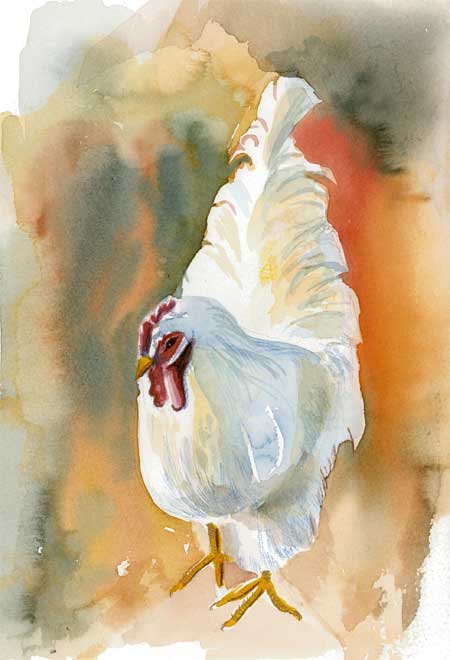
The rooster at the petting zoo was extremely protective of his two hens. He looked pretty good in his crisp white suit. And he knew it.
Art Thought of the Day from Patricia Harrington, in the October 2004 issue of Artist’s Sketchbook:
“A beginning painter can learn about tools and techniques from books and workshops, but if she would just start painting she’d eventually stumble over, back into or just learn most of what she needs to know.”
Me: I’m sure hoping that will start to stumble over what I need to know this year. I read everything I can get my hands on, but at some point you just have to sit down and give it a go. That’s my resolution for the year, so I might as well get started.
Things I’d do differently and things I learned:
More lost and found edges. He looks like a cutout
Think about creating a cast shadow to ground him
Paint on a tilted surface for better control of the wet in wet washes.
More folding
I’ve been continuing with the folds challenge. The more I look around my daily environment, the more I am aware that folds are everywhere. Fabric is only a fraction of the picture. On my desktop I see a folded plastic bag, Kleenex coming out of a box, several pieces of crumpled paper. Out the window leaves are bent and folded. Even mountain ranges are folded. People are practically seas of folds, from their garments to their flesh to the things they carry. So here’s another one …
Three “fold” Path
This week’s challenge for the EDM group was to draw something with folds. I selected the challenge based upon my experience the weekend before – attempting to draw a crumpled comforter in a hotel room. I didn’t get very far with that live drawing as I vastly underestimated the complexity of it and we needed to leave to be somewhere. So I took some reference photos to work on later.
Drawing folds has proven, for me, to be one of the most difficult projects so far. Here are some of the reasons why:
The folded fabric doesn’t look like anything. It’s an abstract design which is mostly about light, shadow, mass, tone, value. Drawing a fold forces you to throw away the crutch of “symbol” drawing and really look at the subject. If I draw a landscape I can draw a the line of distant mountains to ‘suggest’ mountains without having to draw them slowly and carefully as they really are. I can’t do that with folds.
You can get lost in folds. It happened to me over and over. In the time that it took me to look at the subject and look down at the paper, I’d lose my place as though I was walking in a maze. When you draw a face you have landmarks that keep you oriented. The nose goes here. The eyebrows go here. Look out, there’s the ear. These familiar objects let you know where you are as you look-draw-look draw. When you do folds it’s like getting lost in an Escher drawing; up is down and in is out. You think you’re on a hill and find you’re really in a valley. Disorienting.
-Folds are unforgiving. There’s no way for me to just splash some watercolor around and say, hey, there’s a peach. If a fold works, it does. And when it doesn’t, there’s no place to hide.
For all the crabby reasons above, this has actually been one of my favorite challenges. It has forced me to slow waaaay down, to see in finer and finer increments and to think more about where my pen/pencil/brush is going.
I also realize that, in typical Karen fashion, I jumped right into the deep end rather than hanging one simple little dishtowel on a hook and getting the feel of doing some simple “pipe” folds. That’s another thing I learned from this experience – to go back to square one and see if I can draw one fold well before attempting anything so complex.
All that aside, here are three explorations of the comforter, in the order in which I did them: 1) Rapidoliner, 2) #8 round watercolor brush, and 3) pencil (2B and 3B). They were all done on the same type of paper. The top two were of one view, the bottom one was of another.
More drawings from the Simpsons Scoring Session
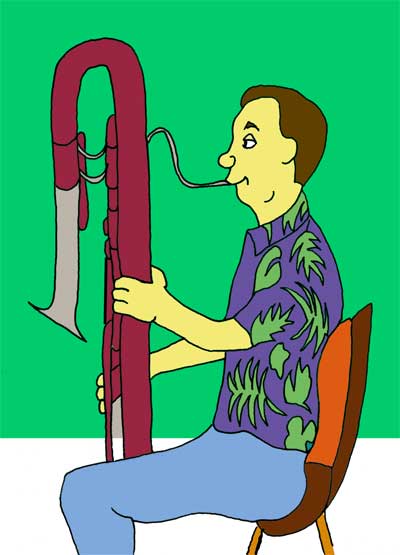
The contrabassoon player. I really liked your Hawaiian shirt. I’m not sure that it had palm fronds and hibiscus but I think most of them do, so I hope you won’t mind that I took liberties with your attire.

A trumpet player, sitting fairly far from me. I’m sorry it doesn’t look like you. About all I could see was that you had a beard. Your horn sounded very good, however.
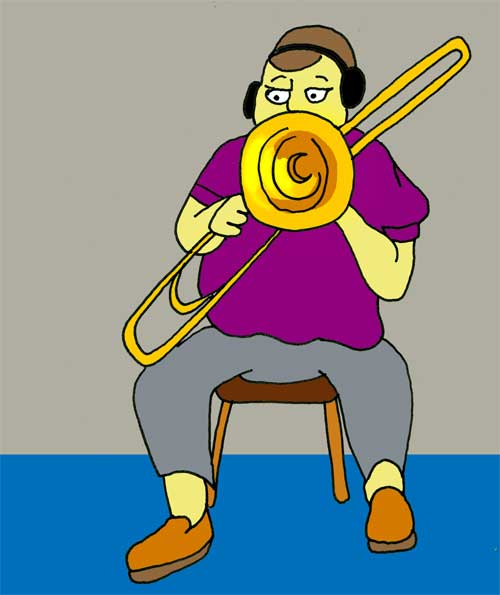
Trombone artist. Same apologies. The bell of the bone was covering your face a lot of the time.
More inking, scanning and coloring of Moleskine drawings from the Simpsons’ Treehouse of Horror music recording session.
I know they don’t look like Moleskines now, but that’s where they started.
If you didn’t see the previous drawings, scroll down to October 10 …
Drawing at the Simpsons’ Scoring Session
Yesterday we had the opportunity to be guests at the orchestral scoring session for the annual Simpsons’ “Treehouse of Horror” Halloween show with composer Alf Clausen, orchestrator Dell Hake and a roomful of tremendously gifted performers. We stayed for the entire morning session and loved every eerie, spine-tingling, rip-roaring moment. We were in the booth half of the time, which is a good distance from the orchestra, but we could still see through the glass.
I had looked forward to drawing the musicians but somehow portraying them ‘realistically’ just didn’t seem appropriate, given the subject matter. So I did it this way, instead. They were drawn in pencil first in my Moleskine … then inked onto tracing paper which was scanned and colorized in Photoshop. Getting likenesses was just about impossible considering that their faces were about as big as a thumbnail held at arms’ length, so I did what I could and ‘winged it’ for the rest. After one of the breaks we were allowed to go inside the recording stage with the musicians provided we didn’t make a sound (no dropping of pencils on the floor.) Since we have always been fans of the long-running series this was a real thrill for us. There’s something magical about being close to a large professional orchestra playing outstanding music to another very, very funny show. Set your TIVOS – don’t miss this one hour special.
I have some more drawings which I’ll post tomorrow or the next day – from the brass and woodwind sections.
